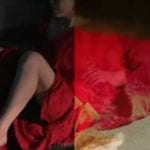 Our World
Our World  Our World
Our World  Pop Culture
Pop Culture 10 Incredible Female Comic Book Artists
 Crime
Crime 10 Terrifying Serial Killers from Centuries Ago
 Technology
Technology 10 Hilariously Over-Engineered Solutions to Simple Problems
 Miscellaneous
Miscellaneous 10 Ironic News Stories Straight out of an Alanis Morissette Song
 Politics
Politics 10 Lesser-Known Far-Right Groups of the 21st Century
 History
History Ten Revealing Facts about Daily Domestic Life in the Old West
 Weird Stuff
Weird Stuff 10 Everyday Products Surprisingly Made by Inmates
 Movies and TV
Movies and TV 10 Actors Dragged out of Retirement for One Key Role
 Creepy
Creepy 10 Lesser-Known Shapeshifter Legends from Around the World
 Our World
Our World 10 Science Facts That Will Change How You Look at the World
 Pop Culture
Pop Culture 10 Incredible Female Comic Book Artists
 Crime
Crime 10 Terrifying Serial Killers from Centuries Ago
Who's Behind Listverse?

Jamie Frater
Head Editor
Jamie founded Listverse due to an insatiable desire to share fascinating, obscure, and bizarre facts. He has been a guest speaker on numerous national radio and television stations and is a five time published author.
More About Us Technology
Technology 10 Hilariously Over-Engineered Solutions to Simple Problems
 Miscellaneous
Miscellaneous 10 Ironic News Stories Straight out of an Alanis Morissette Song
 Politics
Politics 10 Lesser-Known Far-Right Groups of the 21st Century
 History
History Ten Revealing Facts about Daily Domestic Life in the Old West
 Weird Stuff
Weird Stuff 10 Everyday Products Surprisingly Made by Inmates
 Movies and TV
Movies and TV 10 Actors Dragged out of Retirement for One Key Role
 Creepy
Creepy 10 Lesser-Known Shapeshifter Legends from Around the World
10 Optical Illusions That Will Blow Your Brain
Optical illusions are like magicians. They make you question everything your eyes tell you. They’re not just pictures—they’re more like windows into how our brains process information. Get ready for these ten mind-boggling optical illusions to blow your mind. By the time you’re done with this list, you’ll be scratching your head and marveling at the power of your own mind.
Related: Top 10 Simple Things That Mess With The Mind
10 The Vanishing Dots
Imagine a grid of evenly spaced dots on a black background. Simple, right? But when you stare at this grid, something incredible happens – the dots seem to vanish into thin air! It’s like they’re playing a game of hide and seek with your brain.
This optical illusion, the Hermann Grid, occurs because of how your eyes and brain work together. Your eyes have cells that detect contrast. When you focus on one dot, the surrounding dots’ contrast decreases, making them disappear. Your brain is essentially trying to fill in the gaps, and that’s when the magic happens.
What’s truly fascinating about the Hermann Grid illusion is that scientists use it to study visual processing in our brains. Researchers have found that certain cells in the visual cortex, called end-stopped cells, play a crucial role in creating this illusion. These cells are responsible for detecting the edges and boundaries of objects. When you focus on a dot in the grid, these end-stopped cells become activated. They ultimately enhance the illusion of vanishing dots. So it’s not just a simple disappearing act. It’s a glimpse into the intricate workings of our visual system.
9 The Rotating Snakes
Have you ever wished you could witness the snakes dancing without the fear of being bitten? This optical illusion won’t give you a front-row seat to a reptilian tango. But it will make you believe you’re watching snakes slither and twist right before your eyes.
Known as the rotating snake, this mind-boggling image consists of seemingly rotating snakes on a static background. But here’s the kicker—the snakes aren’t actually moving at all! It’s all in your head.
The rotating snake illusion is a prime example of how patterns and contrasts can fool our brains. It’s not just about the snakes. This illusion can appear in various forms, like wheels appearing to spin backward or stationary objects seeming to move. Scientists believe this illusion occurs because our brains are hardwired to detect motion. When they encounter patterns that mimic motion, they fill in the gaps, creating the illusion of movement.
8 The Impossible Triangle
Imagine an object that seems to defy the laws of geometry. That’s what you get with the impossible triangle. Also known as the Penrose Triangle or Tri-bar, this optical illusion presents a three-dimensional triangular figure. It looks like it could never exist in the real world. Each segment appears to connect seamlessly, forming a never-ending loop.
The Penrose Triangle, created by the mathematician Roger Penrose, is a masterpiece of optical art. It continues to intrigue mathematicians and artists alike. What’s remarkable is that this object can be drawn on a flat surface, and it looks plausible when viewed from a specific angle. However, when you try to construct it in three dimensions, you hit a brick wall—it defies the laws of physics.
7 The Ames Room
Welcome to the world of the Ames Room. This mind-bending optical illusion is a specially constructed room that messes with your sense of perspective. When looking into the Ames Room through a peephole, it appears to be a perfectly normal, rectangular space. But when people walk inside, they magically change size, growing or shrinking depending on their position within the room.
The Ames Room is actually cleverly designed with distorted angles and proportions. It fools your brain into perceiving a three-dimensional space that doesn’t exist. The Ames Room is not just a party trick. It has real applications in film and entertainment.
Filmmakers have used this optical illusion to create scenes where characters appear to change size. Remember those scenes in The Lord of the Rings when Gandalf and Frodo looked like they were vastly different sizes? That’s the magic of the Ames Room at work.
6 The Floating Cube Illusion
Imagine a cube that seems to levitate in mid-air, hovering mysteriously before your eyes. This optical illusion challenges your depth perception and your sense of reality. When you look at the cube, it appears to pop out from the background or even rotate without any logical explanation.
Want the truth? The cube is a two-dimensional image cleverly designed to create the illusion of depth and movement. Your brain fills in the missing pieces, making it appear as though the cube is defying the laws of physics.
The floating cube illusion is really all about perspective and shading. The clever use of light and shadow creates the perception of a three-dimensional object where none exists. Artists and designers have used similar techniques to create stunning 3D artworks on flat surfaces, giving the illusion of depth and dimension.
5 The Café Wall Illusion
Have you ever wondered how a simple pattern of black and white tiles could make you question your sense of lines and angles? That’s the magic of the café wall illusion.
Imagine a wall adorned with alternating rows of black and white tiles. At first glance, the lines forming the rows appear slanted. However, when you measure them carefully, you’ll find they are perfectly straight. This optical illusion is an example of how our brains interpret patterns and contrast. It makes us see things that aren’t really there.
The café wall illusion, first discovered in the 1970s, is a striking example of the Gestalt principles of visual perception. It tricks our brains by using contrasting colors and patterns that create the illusion of slanted lines. The horizontal lines are interrupted by alternating rows of black and white squares, which create the misperception of slanting lines. This illusion reminds us that our minds seek patterns and relationships in the visual world. Sometimes leading us to see things that aren’t there.
4 The Ambiguous Cylinder Illusion
Cylinders are pretty straightforward, right? Not when they’re in the world of optical illusions! The ambiguous cylinder illusion challenges your perception by presenting cylinders that look like a mix of squares and circles.
When you view these shapes from different angles, your brain can’t decide whether they’re round or square. In reality, the shapes are cylindrical. But your brain’s interpretation creates the illusion of a shape-shifting object that leaves you questioning the nature of reality. The ambiguous cylinder illusion was first created by Kokichi Sugihara, a Japanese mathematician and artist. Through it, we see the power of perspective and how our brains interpret visual cues.
3 The Blivet
Imagine a bizarre, three-pronged object that seems to defy logic and geometry. This optical illusion, known as the Blivet, presents an impossible object. It has three cylindrical prongs when viewed from one angle but only two when viewed from another. It’s as though the object is constantly morphing and changing shape right before your eyes.
The Blivet is a prime example of how optical illusions can challenge our understanding of the physical world, leaving us in awe of the power of perception. The Blivet, also known as the impossible fork, was first popularized by the artist M.C. Escher.
This illusion plays with our perception of depth and perspective. The Blivet reminds us that our brains constantly interpret visual cues to create a coherent picture of the world. Still, those cues can sometimes lead us to perceive the impossible as possible.
2 The Hollow Face Illusion
What if I told you that a concave object could appear convex? That’s what happens in the hollow face illusion.
Imagine a mask with a hollowed-out, concave face. When you look at it, the face protrudes outward like a regular convex face. Your brain interprets the face based on familiar expectations, assuming it’s convex even though it’s not. This illusion demonstrates how our brain’s prior knowledge and expectations can override what our eyes see.
This leads to a mind-bending experience. The hollow face illusion is a striking example of how our brains use context and prior knowledge to make sense of the world. This phenomenon is not limited to faces; it can also occur with other objects.
1 The Spinning Dancer
Last but not least, we have the Spinning Dancer, a mesmerizing optical illusion that challenges your perception of motion. At first glance, you might see a silhouette of a dancer spinning either clockwise or counterclockwise. Some people see her spinning one way, while others see the opposite. This illusion is a reminder of how our brains interpret visual cues differently. It gives us a taste of the complex inner workings of our visual system.
The Spinning Dancer illusion is often used to illustrate the concept of multistable perception. This means that our brains can perceive the same visual stimulus in multiple ways, and we can switch between these perceptions based on our focus and attention.
When you look at the dancer, your brain processes the image in a way that makes her appear to spin in one direction. But with a shift in your attention, you can make her reverse direction. This phenomenon highlights how our brains constantly interpret and reinterpret the visual world around us.








